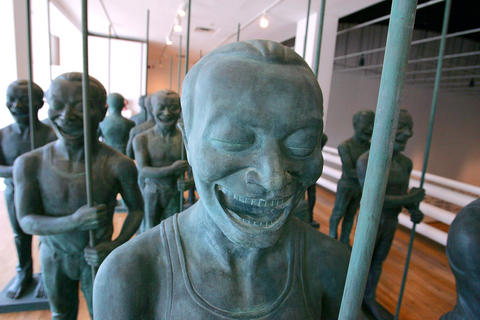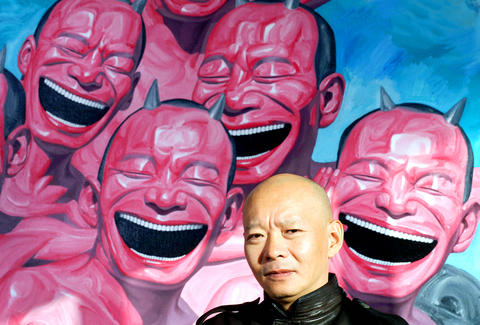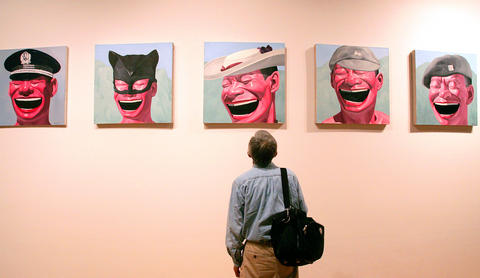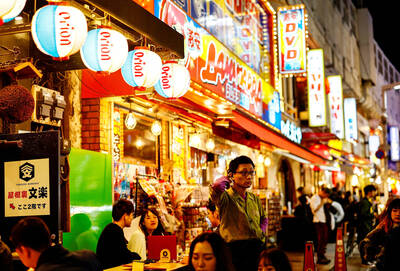Your first reaction upon meeting Yue Minjun (岳敏君) might be, yes, it is indeed he! The face with the enigmatic, jaw-breaking grin, perhaps the most recognizable image in contemporary Chinese painting, is a self-portrait.
"Yes, it's me," Yue said in a recent interview, and he smiled, though in a gentler, less face-splitting fashion than the man in his paintings - the one who drifts Zelig-like past various familiar backgrounds making a sardonic, or perhaps ironically despairing, comment on the passing scene.
Yue, 45, was in New York last month for the opening of an exhibition of his paintings and sculptures that continues through Jan. 6 at the Queens Museum of Art. The show, Yue Minjun and the Symbolic Smile, is the first American museum exhibition of Yue's work and further evidence of his remarkable rise in the superheated field of Chinese contemporary art.

PHOTO: NY TIMES NEWS SERVICE
A few years ago, Yue was eking out a precarious existence in one of Beijing's artist colonies, trying to figure out a way to weave China's tumultuous experience into his works. Now, largely on the strength of that signature grin, he has achieved stardom internationally.
Most conspicuously, one of his paintings, Execution, a satirical Pop Art-like version of Manet's Execution of Maximilian that was inspired by the 1989 crackdown in Tiananmen Square, sold for US$5.9 million last month at an auction at Sotheby's in London. It was a record sum for a contemporary Chinese painting. For Yue, the huge sums suddenly commanded by his works - The Pope, depicting him as a prelate, went for US$4.3 million in June - have involved a readjustment.
"I never thought about this in the past," he said. "What was important to me was the creation part of painting. But it seems that something has changed. Maybe it's the way money is becoming more important in society."

PHOTO: NY TIMES NEWS SERVICE
He is not always comfortable with how his work is analyzed. The mesmerizing enigma of that reddish face painted over and over again, with the wide laugh and the eyes tightly shut from the hilarious strain, is subject to a multitude of interpretations. One Chinese art critic has identified the artist as a member of what he calls the school of "cynical realism," though Yue doesn't feel that he belongs to a school or movement, and he doesn't think he's cynical.
"I'm actually trying to make sense of the world," he said. "There's nothing cynical or absurd in what I do."
Yue was born in 1962 in the far northern Heilongjiang Province of China and as a child moved to Beijing with his parents. He studied oil painting at the Hebei Normal University and graduated in 1989, when China was rocked by student-led demonstrations and their suppression on Tiananmen Square in June of that year.

PHOTO: NY TIMES NEWS SERVICE
"My mood changed at that time," he said. "I was very down. I realized the gap between reality and the ideal, and I wanted to create my own artistic definition, whereby there could be a meeting with social life and the social environment.
"The first step was to create a style to express my feelings accurately, starting with something that I knew really well - myself." That was the first step toward forging what has become the image that has now made him famous. The second step was to devise the laugh, which, he said, was inspired by a painting he saw by another Chinese artist, Geng Jianyi (耿建翌), in which a smile is deformed to mean the opposite of what it normally means.
"So I developed this painting where you see someone laughing," he said. "At first you think he's happy, but when you look more carefully, there's something else there."
"A smile," Yue said, "doesn't necessarily mean happiness; it could be something else."
The smile has been variously interpreted as a sort of joke at the absurdity of it all, or the illusion of happiness in lives inevitably heading toward extinction.
Karen Smith, a Beijing expert on Chinese art, suggests that Yue's grin is a mask for real feelings of helplessness.
"In China there's a long history of the smile," Yue said. "There is the Maitreya Buddha, who can tell the future and whose facial expression is a laugh. Normally there's an inscription saying that you should be optimistic and laugh in the face of reality.
"There were also paintings during the Cultural Revolution period, those Soviet-style posters showing happy people laughing," he continued. "But what's interesting is that normally what you see in those posters is the opposite of reality."
Yue said his smile was in a way a parody of those posters. But, since it's a self-portrait, it's also necessarily a parody of himself, he added.
"I'm not laughing at anybody else, because once you laugh at others, you'll run into trouble and can create obstacles," he said. "This is the way to do it if you want to make a parody of the things that are behind the image."
The real reason he paints himself is that it gives him a greater margin for freedom of expression, he explained.
"It's not a denial of reality but a questioning of it," Yue said. "And that laugh - anybody who's gone through Chinese recent experience would understand it."

May 11 to May 18 The original Taichung Railway Station was long thought to have been completely razed. Opening on May 15, 1905, the one-story wooden structure soon outgrew its purpose and was replaced in 1917 by a grandiose, Western-style station. During construction on the third-generation station in 2017, workers discovered the service pit for the original station’s locomotive depot. A year later, a small wooden building on site was determined by historians to be the first stationmaster’s office, built around 1908. With these findings, the Taichung Railway Station Cultural Park now boasts that it has

The latest Formosa poll released at the end of last month shows confidence in President William Lai (賴清德) plunged 8.1 percent, while satisfaction with the Lai administration fared worse with a drop of 8.5 percent. Those lacking confidence in Lai jumped by 6 percent and dissatisfaction in his administration spiked up 6.7 percent. Confidence in Lai is still strong at 48.6 percent, compared to 43 percent lacking confidence — but this is his worst result overall since he took office. For the first time, dissatisfaction with his administration surpassed satisfaction, 47.3 to 47.1 percent. Though statistically a tie, for most

As Donald Trump’s executive order in March led to the shuttering of Voice of America (VOA) — the global broadcaster whose roots date back to the fight against Nazi propaganda — he quickly attracted support from figures not used to aligning themselves with any US administration. Trump had ordered the US Agency for Global Media, the federal agency that funds VOA and other groups promoting independent journalism overseas, to be “eliminated to the maximum extent consistent with applicable law.” The decision suddenly halted programming in 49 languages to more than 425 million people. In Moscow, Margarita Simonyan, the hardline editor-in-chief of the

Six weeks before I embarked on a research mission in Kyoto, I was sitting alone at a bar counter in Melbourne. Next to me, a woman was bragging loudly to a friend: She, too, was heading to Kyoto, I quickly discerned. Except her trip was in four months. And she’d just pulled an all-nighter booking restaurant reservations. As I snooped on the conversation, I broke out in a sweat, panicking because I’d yet to secure a single table. Then I remembered: Eating well in Japan is absolutely not something to lose sleep over. It’s true that the best-known institutions book up faster